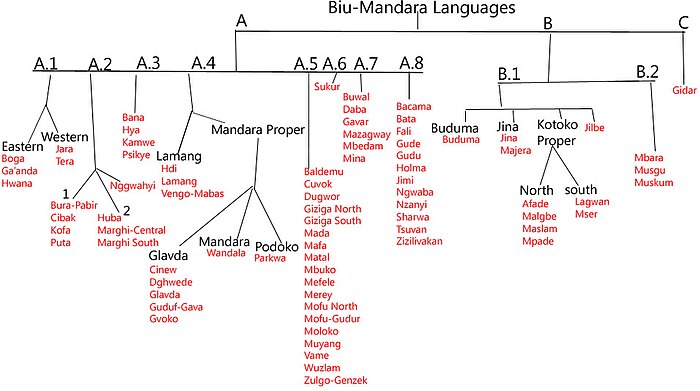Biu–Mandara languages
| Biu–Mandara | |
|---|---|
| Central Chadic | |
| Geographic distribution | Nigeria, Chad, Cameroon |
| Linguistic classification | Afro-Asiatic
|
| Subdivisions |
|
| Glottolog | bium1280 |

The Biu–Mandara or Central Chadic languages of the Afro-Asiatic family are spoken in Nigeria, Chad and Cameroon.
A reconstruction of Proto-Central Chadic has been proposed by Gravina (2014).[1]
Languages[]
Gravina (2014)[]
Gravina (2014) classifies Central Chadic as follows, as part of a reconstruction of the proto-language. Letters and numbers in parentheses correspond to branches in previous classifications. The greatest changes are breaking up and reassigning the languages of the old Mafa branch (A.5) and Mandage (Kotoko) branch (B.1).[2]
- South
- Hurza
- North
- Margi–Mandara–Mofu
- Margi (A.2)
- Mandara (A.4):
- Mofu (part of South A.5 Mafa)
- Tokombere: Ouldeme, Mada, Muyang, Molokwo
- Meri: Zulgo, Gemzek, Merey, Dugwor
- Mofu Proper: Mofu North, Mofu-Gudur
- Maroua
- Maroua (part of South A.5 Mafa (c)): Giziga North, Giziga South, Mbazla
- Lamang
- Higi
- Musgum – North Kotoko
- Kotoko Centre
- Kotoko South
- Kotoko South: Zina, Mazera
- Gidar
- Margi–Mandara–Mofu
Jilbe was not classified, as no sources were available.
Blench (2006)[]
The branches of Biu–Mandara traditionally go by either names or letters and numbers in an outline format. Blench (2006) organizes them as follows:[4]
- Tera (A.1): Tera, Pidlimdi (Hinna), Jara, Ga'anda, Gabin, Boga, Ngwaba, Hwana
- Bura–Higi
- Bura (A.2): Bura-Pabir (Bura), Cibak (Kyibaku), Nggwahyi, Huba (Kilba), Putai (Marghi West), Marghi Central (Margi, Margi Babal), Marghi South
- ? Kofa
- Higi (A.3): Kamwə (Psikyɛ, Higi), Bana, Hya, ? Kirya-Konzəl
- Wandala–Mafa
- Wandala (Mandara) (A.4)
- Mafa (A.5)
- Northeast Mafa: Vame (Pəlasla), Mbuko, Gaduwa
- Matal (Muktele)
- South Mafa
- (a) Wuzlam (Ouldémé), Muyang, Maɗa, Məlokwo
- (b) Zəlgwa-Minew, Gemzek, Ɗugwor, Mikere, Merey
- (c) North Giziga, South Giziga, North Mofu, Mofu-Gudur (South Mofu), Baldemu (Mbazlam)
- (d) Cuvok, Mafa, Mefele, Shügule
- Daba (A.7)
- Bata (Gbwata) (A.8): Bacama, Bata (Gbwata), Sharwa, Tsuvan, Gude, Fali of Mubi, Zizilivakan (Ulan Mazhilvən, Fali of Jilbu), Jimi (Jimjimən), Gudu, Holma (†), Nzanyi
- Mandage (Kotoko) (B.1)
- Buduma (Yedina)
- East–Central
Newman (1977)[]
Central Chadic classification per Newman (1977):

Names and locations (Nigeria)[]
Below is a list of language names, populations, and locations (in Nigeria only) from Blench (2019).[5]
| Branch | Code | Primary locations |
|---|---|---|
| Tera | A1 | Gombi LGA, Adamawa State and Biu LGA, Borno State |
| Bata | A8 | Mubi LGA, Adamawa State |
| Higi | A3 | Michika LGA, Adamawa State |
| Mandara | A4 | Gwoza LGA, Borno State and Michika LGA, Adamawa State |
South[]
| Language | Branch | Cluster | Dialects | Alternate spellings | Own name for language | Endonym(s) | Other names (location-based) | Other names for language | Exonym(s) | Speakers | Location(s) | Notes |
|---|---|---|---|---|---|---|---|---|---|---|---|---|
| Daba | Daba | Daba | A single village, less than 1,000. Mostly in Cameroun | Adamawa State, Mubi LGA. Between Mubi and Bahuli | ||||||||
| Mafa | Mafa | Mafa (Mofa) in Nigeria. Cameroon dialects divided into West, Central and Eastern. | Mofa | Matakam (not recommended) | 2,000 (1963), 136,000 in Cameroon (1982 SIL) | Borno State, Gwoza LGA; mainly in Cameroon | ||||||
| Sakun | Sukur | Sakun, Gemasakun | Gә̀mà Sákún | Sugur | Adikummu Sukur | 5,000 (1952); 10,000 (1973 SIL). 7 villages | Adamawa State, Madgali LGA | |||||
| Ga’anda cluster | Tera | Ga’anda | Tlәka’andata pl. Ka’andәca | Kaɓәn | Mokar [name of the place where the rolling pot stopped] | 7,600 (1952); 10,000 (1973 SIL);␣4. Six villages | Adamawa State, Gombi LGA | |||||
| Kaɓәn | Tera | Ga’anda | Gabin | Tlәkaɓәnɗa pl. Kaɓәnca | 12 villages | |||||||
| Fәrtata | Tera | Ga’anda | Tlәfәrtata pl. Fәrtaca | 5 villages | ||||||||
| Boga | Tera | Boka | 5 villages | Adamawa State, Gombi LGA | ||||||||
| Hwana | Tera | Hona, Hwona | 6,604 (1952 W&B); 20,000 (1973 SIL), estimate more than 20,000 (Blench 1987) | Adamawa State, Gombi LGA, Guyuk and 30 other villages | ||||||||
| Jara | Tera | Jera | 4,000 (SIL) | Borno State, Biu LGA; Bauchi State, Ako LGA | Also refers to the languages of the Jarawan Bantu group including: the Jarawa cluster, Mbárù, Gùra, Rúhû, Gubi, Dulbu, Láb |